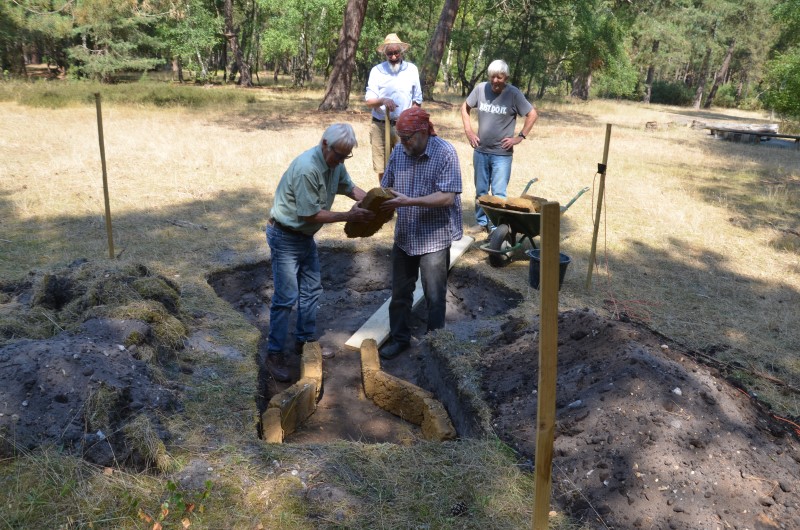Featured image: Volunteers building the replica Ipswich ware kiln
Here is another instalment of the Being Anglo-Saxon series, following the progress of the Rendlesham Revealed experimental archaeology kiln. Faye Minter tells us all about the building of the kiln structure.
In summer 2022, a small group of volunteers started building the structure of the kiln, overseen by the two experts leading the project: Keith Wade (retired county archaeologist and specialist in the Anglo-Saxon archaeology of Ipswich) and Duncan Allan from Hands on Heritage.
To build the kiln, several things needed to be done. To start off, Keith with input from the volunteers, researched kiln structures and sketched a plan based on the excavated example from the Buttermarket, Ipswich. Wooden moulds were also made for the building “blocks” for the structure.
Then over 3 days, the team and volunteers were on-site at the Hands on Heritage experimental archaeology site to begin the build.
Day 1
On the first day, we measured and marked out the layout of the kiln in plan on the ground. This area was then de-turfed and the kiln footprint dug out to 50cm deep.


In the meantime, volunteers were preparing the clay that would be used to make the building “blocks” for the kiln structure. Boulder clay was provided by Bulmers Brick and Tile Company and sand was dug from a nearby sand pit in the forest.
Using spades, 1 part boulder clay was mixed with 1 part sand on a 1.5sqm tarpaulin. Once mixed, water was added – but the spades were less effective now the mixture was wet, so one volunteer suggested stamping the mixture with their feet, this worked better and everyone was very willing to give it a go, and soon the mixture had an elastic consistency. One quarter bale of straw was then added, and again there was more stamping with feet to mix this in.
This process took several hours.
When the mixture was ready, the volunteers attempted to make two blocks as samples. To do this, the wooden moulds were used, first water was used to dampen the moulds and then a thick layer of sand to line it before the clay mixture was pressed into the mould. We were all thrilled to see that the blocks came out perfectly!


Day 2
On the second day, the main task was to continue making the building “blocks”. We mixed up another load of clay-mix. Together, we made 35 blocks and these were stored on-site under cover to dry out for a couple of weeks.
Making the blocks was very physically demanding as you can imagine, especially banging the blocks on the floor to get them out of the moulds. But everyone was very pleased with the results.


The Final Day
On the final day, we started building the kiln structure using the newly-made building “blocks”, which were stuck together with a wet clay mix. In the afternoon the volunteers made several replica Ipswich ware pots. Once the main structure was complete, the kiln was left over summer to dry out.
The plan was to return in September to fire the kiln, however due to the summer heatwave and tinder conditions it was not safe, so the firing was postponed until the spring 2023. Over winter, the kiln was protected under tarpaulin and the Hands on Heritage staff kept an eye on it. When we return in Spring 2023, the kiln will need drying out again before the main firing with pots can begin.



Keep an eye out for updates later in the year to see the results of the firing.
Find out more
Discover more about the Rendlesham Revealed project
This experimental archaeology project is part of the community archaeology project Rendlesham Revealed: Anglo-Saxon Life in South-East Suffolk, funded by the National Lottery Heritage Fund. We are very grateful to our many local and national partners who have made this project possible, and for the support of our volunteers and of the landowners and farmers who work and manage this historic landscape.






